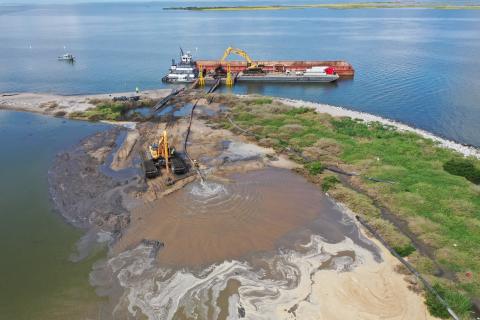A Deepwater Horizon project to restore 37 acres of prime bird nesting habitat on Louisiana’s Queen Bess Island kicked off recently. Its start hinged on efficient coordination among partners to get the project moving successfully ahead of a tight timeline.
Located about two-and-a-half miles north of Grand Isle in Barataria Bay, the island had been sinking and eroding into the Gulf of Mexico. Less than five acres of suitable bird habitat remained. Despite its size and condition, more than 60 species of birds use it as habitat, and it is the third largest colonial waterbird colony in Louisiana.
When completed, this restoration project will provide 30 acres of restored Brown Pelican and wading bird habitat, and seven acres of nesting tern and Black Skimmer habitat. Included in the project is marsh habitat accessible by fish and protected by a breakwater to reduce wave and tidal erosion. A row of breakwaters on the south side of the island will be installed to give young birds a safe, calm area for swimming.
Rebuilding the land starts by barging Mississippi River sediment to the project site. Then, the sand is pumped onto the remnant island to reach elevations varying based on the target habitat for each area. With the exception of the habitat for terns and skimmers that prefer barren ground, most areas will be planted with native vegetation.
The $18.7 million project, approved in March 2019, has only a six-month construction window to get the work done between the end of one nesting season and the start of the next one. Strong cooperation with partners in the U.S. Army Corps of Engineers helped streamline the permitting process so restoration work on Queen Bess could get underway quickly, avoiding a significant delay. Both the Department of the Interior and NOAA expedited reviews under the Endangered Species Act and Magnuson Stevens Act as part of the streamlined processes set up for Deepwater Horizon projects.
Successful partnerships can help advance Gulf restoration in innovative ways; in this case we were able to design the project and get it on the ground sooner and more quickly restore habitat for Louisiana’s iconic brown pelican and other species injured by the Deepwater Horizon oil spill. Other project partners included Louisiana’s Oil Spill Coordinator’s Office, Department of Environmental Quality, Department of Wildlife and Fisheries, and Department of Natural Resources and the U.S. Departments of Environmental Protection and Agriculture.


